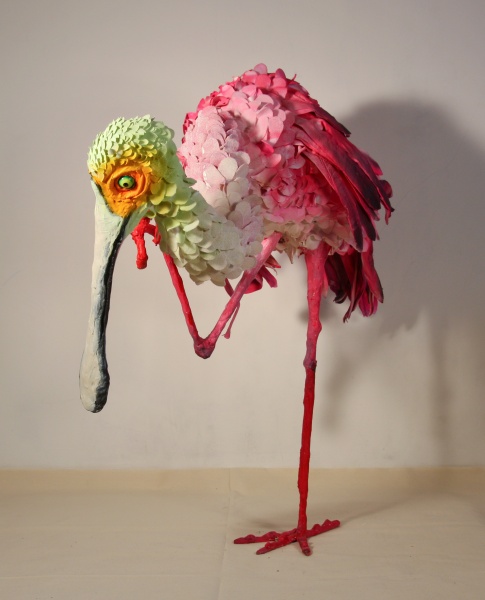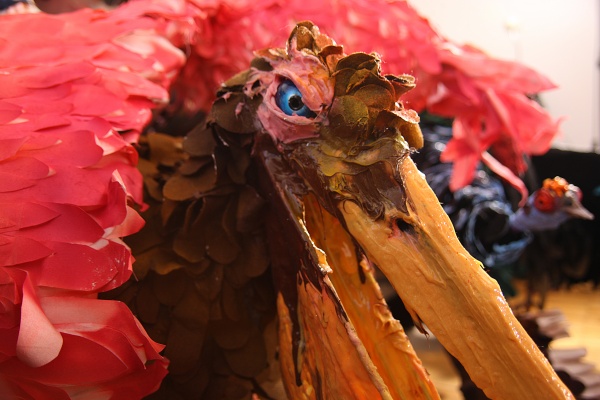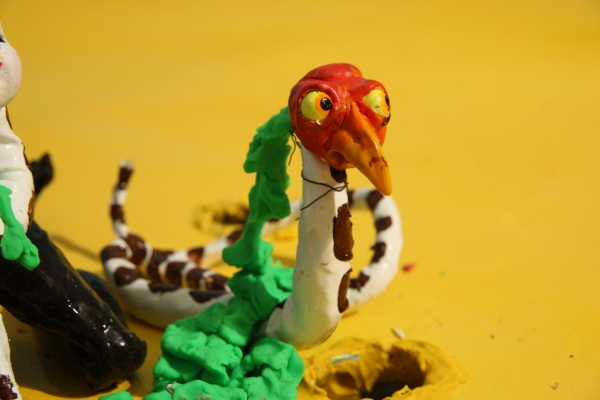The Things We Don’t Talk About
Miranda Trimmier offers a fearlessly candid critical response to Nathalie Djurberg's violent, libidinally charged stop-motion animated shorts and installation - on view in the Walker's exhibition of her new work, "The Parade," through December 31.







HOW DO WE TALK ABOUT THE THINGS THAT ARE HARD TO TALK ABOUT?
Perhaps we must begin in a small, dark space: a cave, an underground tunnel, a windowless room. That way we’re forced to move with care, to use words thoughtfully and listen with honest ears. We should breathe softly in such a space; there’s no room for hot air. And when our limbs cramp, when we become disoriented, we have to stay put, with only discomfort as our throughway.
Because this was the gauntlet thrown down at the Walker Art Center on the opening night of Nathalie Djurberg’s new film and installation piece, The Parade. The WAC representative who introduced the artist — and a short series of her early claymation shorts, screened specially for the opening — did so with reference to her express belief that “art is for the things you don’t dare talk about.” Djurberg, called up to the stage, added little save to say that she would be leaving the room as the films showed. She couldn’t bear to watch the audience respond to her work: “Too embarrassing,” she shivered. No one was going to get off so easily, though. The program was to be followed by a question-and-answer session, and in the end, the audience had come to see what Djurberg and the curators had to say. Even after the screening — after we experienced all those taboo things and the nervous laughter, thrills of arousal, and loaded silences they provoked — it was hard, as an audience member, not to hope for a dialogue that sidestepped all these conversational difficulties and accomplished something meatier. That is, when the talk proved, however predictably, to be awkward and stilted, many of us still wished it could have gone differently.
How can we speak more satisfyingly about these things?
Maybe we can get at them with our bodies, in a twitch that startles the arm, a gasp that grips the chest. How we blink and blink and sleep, heavily; how our drooping eyelids cycle through seasons or an age. The way a waistline fattens; the way a muscle wastes. These strange sums tallied in guts and calculated in beating hearts and blood that thins, then thickens, in turn.
One of the first things you notice about Djurberg’s work is her characters’ bodies. Fashioned inexpertly from plasticine and wire, they are scrappy; but even more, they are distressed, lumpy and knock-kneed, with disconcertingly tensed facial muscles and weird lolling eyeballs. They appear pained. And yet they tend to move in ways that flow quite naturally, perhaps because Djurberg uses her own body to model their movements[i], practicing alone in her studio until she hits on something that looks and feels right. I imagine that a fly on the wall, witnessing these private experiments, would get an eyeful. Because, once set in motion, Djurberg’s characters are most often fucking or abusing one another, spewing bodily fluids all over the place and behaving like sadistic animals. But Djurberg ensures that, even at their most debased, they strike us as altogether familiar.
Do we really want to talk about that?
It would help to have sex, though we ought to start by touching ourselves. If at first our fingers grope timidly, they find themselves quickly and glide along well-worn paths. Soon we’re pulling and slapping and cursing and shouting, the guttural work that at other times we call exalted. But in its grips, we know it to be nothing of the sort. No, nothing of the sort: just plain and beasty want.
Sex, in Djurberg’s work, is plentiful and ugly. It takes place as often between three or four people as it does two, in varying degrees of consent. Or between people and animals: the content of Tiger Licking Girl’s Butt, for instance, follows fairly literally from its title. But to say that her films are filled with sex isn’t to guarantee that you’ll see any. It’s to say, more precisely, that her films carry an unmistakable libidinal charge. Unlike the Djurberg films shown on opening night, the ones featured in The Parade feature little explicit sex, and yet their unabashed violence, greed, and gluttony is palpably erotic. One of the most unsettling things you can do while watching Djurberg’s films is to take note of the moments in which you get aroused. It happens whether you want it to or not, and often just as the material gets particularly mean and repulsive.
What are we supposed to say about that?
If things get too intense, we might choose to play music. It’s ok, even preferable, if we’re terrible musicians. We should choose bass-y instruments that vibrate up through the floor or arid ones that sound like bones. The rhythms shouldn’t and won’t; they’ll rush, bunch, trip, and form unstable pools that soak into our kidneys and echo down our spines.
Djurberg has collaborated for years with Hans Berg, who crafts the strange soundscapes that accompany her films. As she tells the story, she’d almost given up on working with musicians and composers; they’d proven themselves, again and again, to be over-practiced and stiff. But Berg’s first composition for Djurberg set one of her shorts to a creepy track looped with mewling cats. She was impressed with his work, and relieved to find him; they have worked together ever since. The partnership thrives, according to Djurberg, because Berg has a knack for finding the tensions in her films, tensions even she might have missed, and for making music that deepens them. He also understands her sometimes-cryptic aural requests, which she tends to articulate through sensory proxies: “the music should be more yellow”; “I want this to sound like building blocks.”
But we are starting to wander now. What, exactly, are we talking about?
If we begin to feel lost, we can always make a list, of, say, every synonym for egg. Then another, of every word for dirt, and every word for sand, and time, and death. We will paste them up in jumbles all around us, admiring our word-hoards before we snatch them down, shred them, and — of course — set them on fire.
______________________________________________________
One of the most unsettling things you can do while watching Djurberg’s films is to take note of the moments in which you get aroused. It happens whether you want it to or not, and often just as the material gets particularly mean and repulsive.
______________________________________________________
On first impression, Djurberg and Berg seem to be the sort of people who’ve learned to exist comfortably in silence. When they have to talk to one another about the things they’re making, Djurberg says they “talk around” them. It is unclear whether it’s the content of the films or Djurberg’s unconventional process that mandates this circuitousness. It is unclear, for that matter, whether it was the content of the films or Djurberg’s process that made the Walker dialogue on opening night so disappointingly insubstantial. Probably it’s both, which suggests another way to formulate Djurberg’s conviction that “art is for the things we don’t dare talk about“: art is the thing we don’t dare talk about. At least not art like The Parade, which is too tenebrous and odd to be talked at directly. We develop strategies to talk around such pieces, both linguistically, with the words of the critic or poet or cryptic synesthete, and extra-linguistically, through vernaculars of space or movement or sex or music. Still, in the end, we can really only say so much — even when we’re able to feel our way into fruitful conversation, our small, dark space may resist our efforts to illuminate and control it, dropping out beneath our feet and furrowing like a rabbit hole.
When our space and our talk have exhausted themselves, it’s time to head outside, where fresh air is a mercy. We should exit at night so our faces stay shadowed and nameless. The breeze brings a silence that swallows each thing our words have touched. We won’t be able to recover them all; they will only be gotten back in bits and hiccups. But this, too, is a mercy, though that’s another word we will forget.
When talk is no longer tenable, there is always this silence. When Djurberg’s question-and-answer session ended, the audience scattered-some to take a look at The Parade, some to cash in the free drink tickets given us by the ushers, some to escape into the night for a cigarette. Those of us who stepped out took seats at the picnic tables lining the WAC’s big open yard, in arrangements of twos, threes, and fours. Some talked — slowly, quietly, in the intimate way people do when they’re tired. But many didn’t, sitting instead in silence and processing what we’d just witnessed. The air felt weighted with half-chewed thoughts. Maybe if we are going to talk about the things we don’t talk about, we ought not discount these silent moments, or, for that matter, those lulls in the lecture hall. Perhaps they’re not simply conversational failures, but another communicative substance with a space, movement, sex, and rhythm all its own, a logic of expression with an attendant set of possibilities and limitations. And so, then, to ask how we should talk about the things we don’t talk about is also to ask what role silence plays, to wonder how it exists as a linguistic strategy within a dialogue that grapples thoughtfully with these hard, murky, human things.
[i] All claims about Djurberg’s work and process are based on statements made by her or WAC curators on the opening night of The Parade and retrieved-as respectfully as possible and in varying degrees of accuracy-from my memory.
______________________________________________________
Related links and information:
The Parade, short films and sculptures by Nathalie Djurberg with music by Hans Berg, will be on view at the Walker Art Center in Minneapolis through December 31. The noted screening and dialogue with the artists took place opening day, September 8, at the Walker Art Center.
______________________________________________________
About the author: Miranda Trimmier spends a lot of time reading, writing, and making things, and is grateful to K. Galanos for the thought-provoking dialogue around the things we don’t talk about.